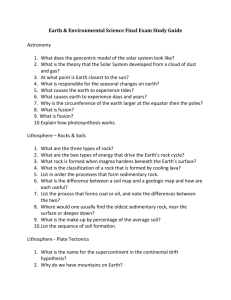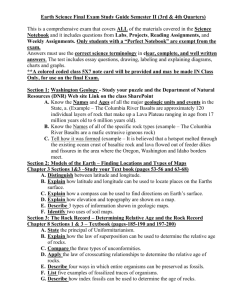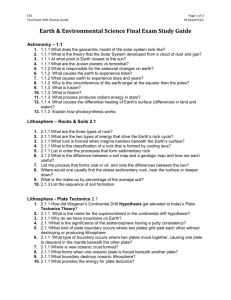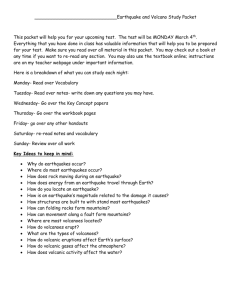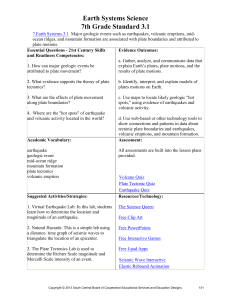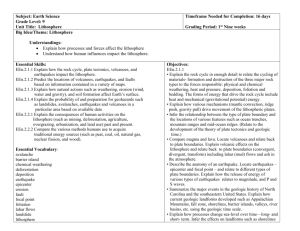Midterm Study Guide
advertisement
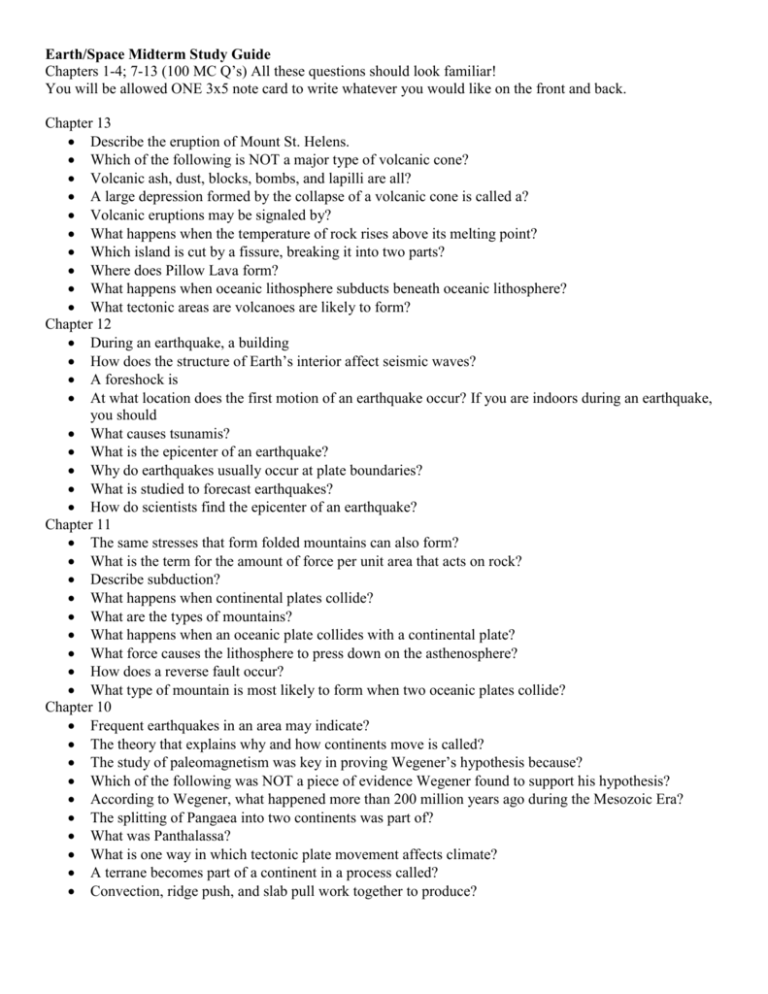
Earth/Space Midterm Study Guide Chapters 1-4; 7-13 (100 MC Q’s) All these questions should look familiar! You will be allowed ONE 3x5 note card to write whatever you would like on the front and back. Chapter 13 Describe the eruption of Mount St. Helens. Which of the following is NOT a major type of volcanic cone? Volcanic ash, dust, blocks, bombs, and lapilli are all? A large depression formed by the collapse of a volcanic cone is called a? Volcanic eruptions may be signaled by? What happens when the temperature of rock rises above its melting point? Which island is cut by a fissure, breaking it into two parts? Where does Pillow Lava form? What happens when oceanic lithosphere subducts beneath oceanic lithosphere? What tectonic areas are volcanoes are likely to form? Chapter 12 During an earthquake, a building How does the structure of Earth’s interior affect seismic waves? A foreshock is At what location does the first motion of an earthquake occur? If you are indoors during an earthquake, you should What causes tsunamis? What is the epicenter of an earthquake? Why do earthquakes usually occur at plate boundaries? What is studied to forecast earthquakes? How do scientists find the epicenter of an earthquake? Chapter 11 The same stresses that form folded mountains can also form? What is the term for the amount of force per unit area that acts on rock? Describe subduction? What happens when continental plates collide? What are the types of mountains? What happens when an oceanic plate collides with a continental plate? What force causes the lithosphere to press down on the asthenosphere? How does a reverse fault occur? What type of mountain is most likely to form when two oceanic plates collide? Chapter 10 Frequent earthquakes in an area may indicate? The theory that explains why and how continents move is called? The study of paleomagnetism was key in proving Wegener’s hypothesis because? Which of the following was NOT a piece of evidence Wegener found to support his hypothesis? According to Wegener, what happened more than 200 million years ago during the Mesozoic Era? The splitting of Pangaea into two continents was part of? What was Panthalassa? What is one way in which tectonic plate movement affects climate? A terrane becomes part of a continent in a process called? Convection, ridge push, and slab pull work together to produce? Chapter 9 What was the first period of the Mesozoic Era called? The most common Precambrian fossils are? The appearance of many new life-forms during the first period of the Paleozoic Era was probably aided by the development of? Why is the Precambrian rock record difficult to interpret? The Pliocene Epoch began about 5.3 Ma, otherwise known as? On a geologic column where are the oldest rocks? What happened when temperatures decreased during the ice ages of the Cenozoic Era? What is the name for an armored Cretaceous dinosaur? The end of the Permian Period was marked by? The first amphibians, which appeared during the Devonian Period, were from what genus? Chapter 8 Why is radioactive decay used to determine the absolute age of rocks? Using rates of erosion to determine the absolute age of a geologic feature is practical only for features formed within the past . If an igneous intrusion is observed through a layer of sedimentary rock, what geological law or principle applies? What are Carbon Films? What is a gastrolith? How is radioactive decay used to determine the absolute age of rocks? Chapter 7 Coal deposits are formed by? The process by which ores are formed when magma meets existing rock and changes the rock’s composition is called? A process that reduces the amount of damage mining does to ecosystems is? A mining method in which overlying rock material is stripped away to reveal mineral deposits is? Splitting the nucleus of a large atom into two or more smaller nuclei is called? A fossil fuel formed by the remains of prehistoric organisms that accumulated in shallow oceans and lakes is? The mineral calcite is commonly used in? What is released in large amounts when coal with a high sulfur content is burned? An energy source that heats fuel rods to create steam for electric generators is? A heating system that uses solar collectors is a(n) . Chapter 4 What describes how substances react to form new substances? How do compounds differ from mixtures? Two types of chemical bonds are? In the chemical formula CO2, what does the subscript “2” mean? Where are electrons found in atoms? Density, color, and boiling point are examples of? What are used to balance chemical equations? Within each column, or group, on the periodic table, the different elements’ atoms usually have the same number of? The attractive force between oppositely charged ions that result from the transfer of electrons from one atom to another is known as? How are the elements on the periodic table arranged? Chapter 3 Latitude and longitude can locate a place on Earth’s surface by describing its position in degrees, minutes, and seconds? What is longitude? What is latitude? Who uses soil maps? What is a compass rose? The science of making maps is called? What information is shown on geologic maps? Chapter 2 The shape of Earth most closely resembles what? How does the transfer of energy throughout an ecosystem begin? List three factors that control the balance of an ecosystem? What are the different parts of the compositional structure of Earth? What is the approximate average circumference of Earth? Who was the first to explain the effects of gravity in his law of gravitation? What are the important sources for energy in the Earth system? What is involved in the movement of matter and energy between reservoirs? Ecosystems respond to environmental change by? What is a probable source of Earth’s magnetic field? Chapter 1 A system of ideas that explains many related observations and is supported by a large body of evidence acquired through scientific investigation is called a? Rocks and minerals were cataloged around 200 BCE by who? Earth science is the scientific study of? Which ancient culture kept records of earthquakes as early as 780 BCE? How does science impact society? Earth scientists assume that the causes of natural events or phenomena can be determined by? What contribution did the Maya make to modern science? Earth scientists help us better understand the world around us by studying?


